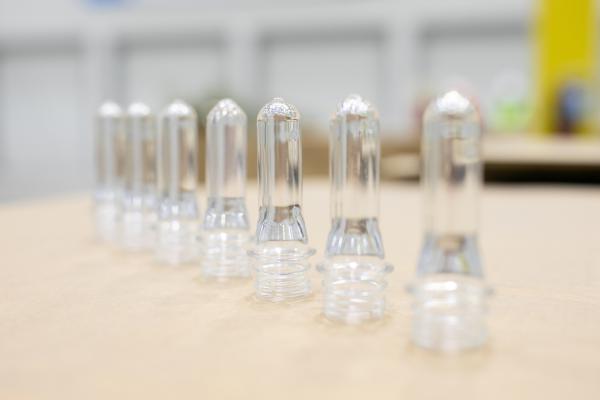Plastics and Rubber
rPlanet Earth is a rarity in the plastics recycling and manufacturing industry. After all, its operation in Vernon, California, is the world’s only vertically integrated facility able to convert polyethylene terephthalate (PET) packaging waste into recycled PET (rPET) packaging for food and beverage industries. Yet, rPlanet Earth is much like any other plastics company in one key aspect: it must maintain production efficiencies to meet growing demand for its high-quality products.
An Illinois protective packaging manufacturer was able to reduce their cooling costs by over 60% while also saving around $100,000 each year on system maintenance by replacing their old system with high-efficiency equipment and a streamlined hydronic design. Helped by ComEd efficiency incentives, the plant captured these benefits through an under 2.4 year payback system upgrade project.
[ Read Full Story ]
Our simplified business model is to melt plastic and cool it back into the form we want – and cooling water makes this happen. We need to optimize chilled water temperature and flow to ensure that our production machines make consistent finished products. In molding application, we cool the plastic through conduction and convection directly. Blown film is different in that cooling-water cools the air and then an air handler cools the plastic.
[ Read Full Story ]
In February 2021, Chiller & Cooling Best Practices Magazine interviewed members of the Intertape Polymer Group Inc. (IPG) Sustainability Pillars team to gain an understanding of the work being done to improve energy efficiency. The team members interviewed were Michael Jones (Director of Corporate Energy), Michael Deitering (Senior Project Engineer), Jarrod Knapp (Maintenance Manager) and Mark Secord (Engineering Group Leader).
[ Read Full Story ]
Schoeneck Containers, Inc. (SCI) is a company that thinks a lot about its future – and how to continue to maintain a long track record of profitability and reliability while meeting a growing demand for its quality plastic containers for customers throughout North America. It’s the kind of thinking driving the decision to install a closed-loop adiabatic fluid cooler and central chiller with free-cooling capabilities at the company’s new 250,000-square-foot production facility in Delavan, Wisconsin.
[ Read Full Story ]
At the company’s production plant employees manufacture a complete range of engineered, high-performance polymers. At the heart of the operation are numerous extrusion lines and related equipment that operate 24 hours a day, five days per week to produce and ship as much as five million pounds of high-performance polymer pellets each month. The process of producing pellets begins when the rotating screw on each extruder accepts a carefully calibrated mix of thermoplastic materials, as well as additives, from a hopper and pushes the mixture into the extruder’s barrel.
[ Read Full Story ]
The NPE 2018 International Plastics Showcase was held at the Orange County Convention Center in Orlando, Florida, May 7-11. Setting all-time records, the Show attracted 2,180 exhibitors — including Chiller & Cooling Best Practices and Compressed Air Best Practices® Magazines! Over 1,200,000 square feet of exhibition space was used, breaking the all-time NPE record. Held once every three years, NPE 2018 registered attendance was 56,000.
[ Read Full Story ]
A common misconception in plastics injection molding is that coolant temperature is the one true path to achieve productivity and profitability. The reality, however, is that turbulent flow is the primary force behind efficient cooling and a key driver in the ability to achieve operational efficiencies, increase profits and consistently produce high quality products.
[ Read Full Story ]
One of the most important steps in the mold making process is a consistent and proper cooling cycle. This is due to the fact cooling rates can have a significant influence on the overall quality of the finished item. The cooling cycle must remain consistent throughout the entire production run to ensure all items are equal in quality.
[ Read Full Story ]
Plastics processors are looking to advanced process cooling equipment to lower operational costs, and in many cases, improve the quality of products and achieve sustainability goals. But it’s more than just a matter of finding a better mousetrap and putting systems to work. Instead, it requires a keen understanding of the processes involved, followed by the design and installation of advanced technology in combination with the right process cooling systems matched to a company’s goals.
[ Read Full Story ]
Controlled cooling is an essential part of manufacturing polyethylene stretch film. The process starts with granulated polyethylene raw product with very low strength, and develops thin, clear, strong film used in a variety of applications. It does this by melting, extrusion, “casting” and winding. See Figure 1 for a typical system diagram. “Casting” is forming and cooling at the same time. The extruded polymer is stretched and cooled on large, chrome-plated rollers with cooling water flowing inside. Thinner film is for manual use, like wrapping around food products. Thicker, stronger product is made for machine use, like automatically wrapping pallets of concrete bags.
[ Read Full Story ]

